The Labtoratory of Ultrasonic Methods deals with both experimental and theoretical research in the field of Mechanics of Materials:
All of the above listed phenomena exhibit strong thermomechanical coupling (i.e. coupling between mechanics and thermal effects) and their investigation requires advanced experimental techniques as well as multi-scale mathematical models. Their use for evaluation of thermomechanical properties of the examined materials (i.e. their elastic constants) usually requires complex and ill-posed inverse problems to be solved and Monte-Carlo simulations to be performed in order to obtain realistic estimation of experimental errors.
The particular issues studied in the laboratory include:
Non-contact resonant ultrasound spectroscopy (RUS) |
|
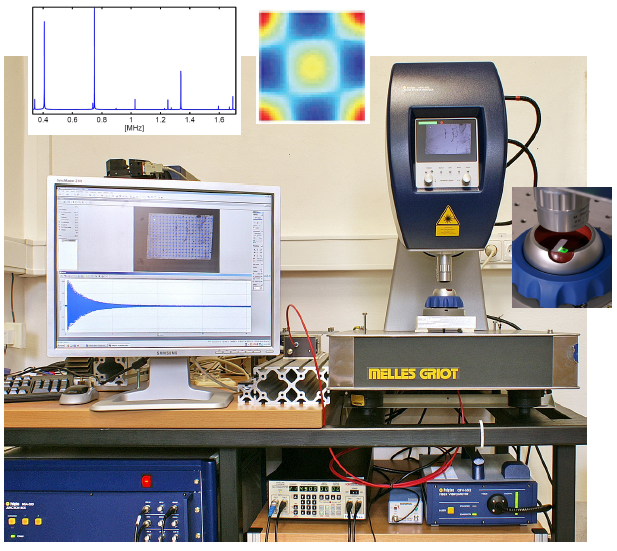 |
By using lasers both for the generation and for the detection of elastic vibrations, the resonant spectra of the specimens of the examined materials are obtained in a fully non-contact regime, i.e. not biased by any clamping forces from the ultrasonic probes. Simultaneously, the detecting laser beam scans the surface of the specimen, and thus, not only the resonant frequencies but the shapes of the eigenmodes are obtained. Responsible researchers: Michal LANDA, Lucie BODNÁROVÁ-BICANOVÁ Instrumentation: PolyTec MicroSystem Analyzer Related publications: [NOVA-09], [MSEA-09], [APA-09]
|
Numerical solution of the inverse problem of RUS
|
|
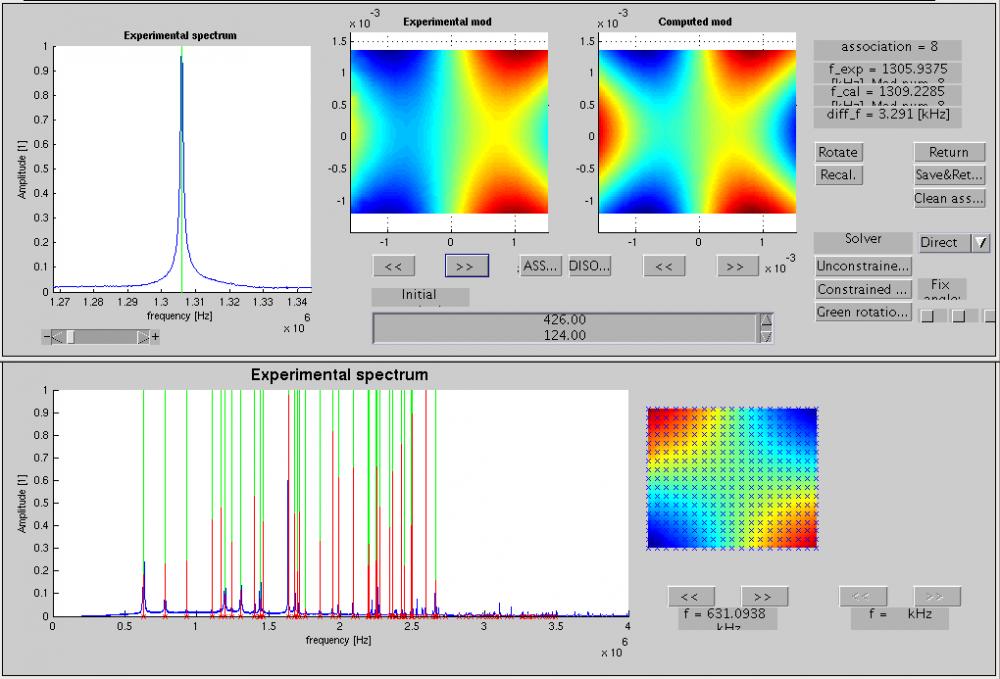 |
The determination of elastic coefficients from the resonant spectra is done inversely, i.e. the coefficients are tuned such that the spectra evaluated for them fit the experimental data in some optimal way. On this purpose, a software toolbox running under Matlab is developed, which enables not only the inverse determination of the elastic coefficients, but provides reliable estimates of the accuracy, and can be used also for calculation of thermal dependencies of individual coefficients, attenuation coefficients or determination of the material symmetry class. Responsible researcher: Petr SEDLÁK Related publications: [AM-09], [APA-09], [NOVA-09], [IEEE-06] |
Measurements of elastic coefficients of individual phases of shape memory alloys and their thermal dependencies close to the transition temperatures |
|
 |
Shear softening in single crystals of austenite and single variants of martensite of the shape memory alloys (SMAs) in the vicinity of the transition temperatures is investigated by various ultrasonic methods (pulse-echo technique, RUS). For the ferromagnetic SMAs (e.g. Ni-Mn-Ga), the effect of the external magnetic field and the related magneto-acoustic phenomena (especially the damping) are also analyzed. Responsible researcher: Michal LANDA Collaboration with: IoP ASCR, Helsinki University of Technology. Related publications: [JALCOM-12a], [APA-09], [MSEA-09], [MSEA-08], [MSEA-07], [AM-05], [JAC-04], [MSF-05], [ULT-04b], [NOVA-09], [IEEE-06] |
Measurements of in-plane elastic coefficients of thin surface coatings and layers |
|
 |
The elastic coefficients of thin (<1µm) surface layers are determined from differences between resonant frequencies of the substrate with and without the layer. This method is used for evaluation of DLC and SMA coatings. Responsible researcher: Michal RŮŽEK, Petr SEDLÁK Collaboration with: IoP ASCR, IFW Dresden. Related publications: [WIT-09], [JASA-10]
|
Experimental determination of the symmetry class and elastic coefficients of ultra-finely grained materials
|
|
 |
The resonant ultrasound spectroscopy in combination with pulse-echo measurements is used to analyze anisotropic elasticity of ultra-finely grained polycrystalline metals produced by equal channel angular pressing (ECAP). The symmetry of the examined material is estimated by a numerical search for planes of mirror symmetry. Responsible researcher: Hanuš SEINER Collaboration with: Charles University in Prague Instrumentation: Polytec MicroSystem Analyzer Related publications: [AM-09] |
Ultrasonic evaluation of fibrous composites |
|
 |
By using a combination of various ultrasonic methods (immersion techniques, point-source/point- receiver measurements) anisotropic elastic coefficients of fibrous composites are determined, either from velocity of propagation of bulk elastic waves, or by an inversion of dispersion curves of Lamb waves in thin plates. Responsible researcher: Michal LANDA Collaboration with: VZLÚ Letňany Related publications: [ULT-06], [ULT-04a] |
Elasticity of martensitic microstructures |
|
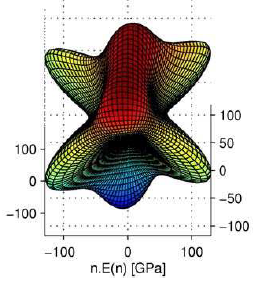 |
By using a simple homogenization procedure, the averaged elastic properties of various microstructures thermoelastic martensites (differing in twinning systems, volume fractions, order of the laminate etc.) of can be evaluated. This enables the elastic coefficients of individual components to be determined from measurements of elasticity of the variously microstructured crystals. Responsible researcher: Hanuš SEINER Related publications: [APA-09], [IJMCE-09] |
Experimental observations of interfacial microstructures in single crystals of shape memory alloys |
|
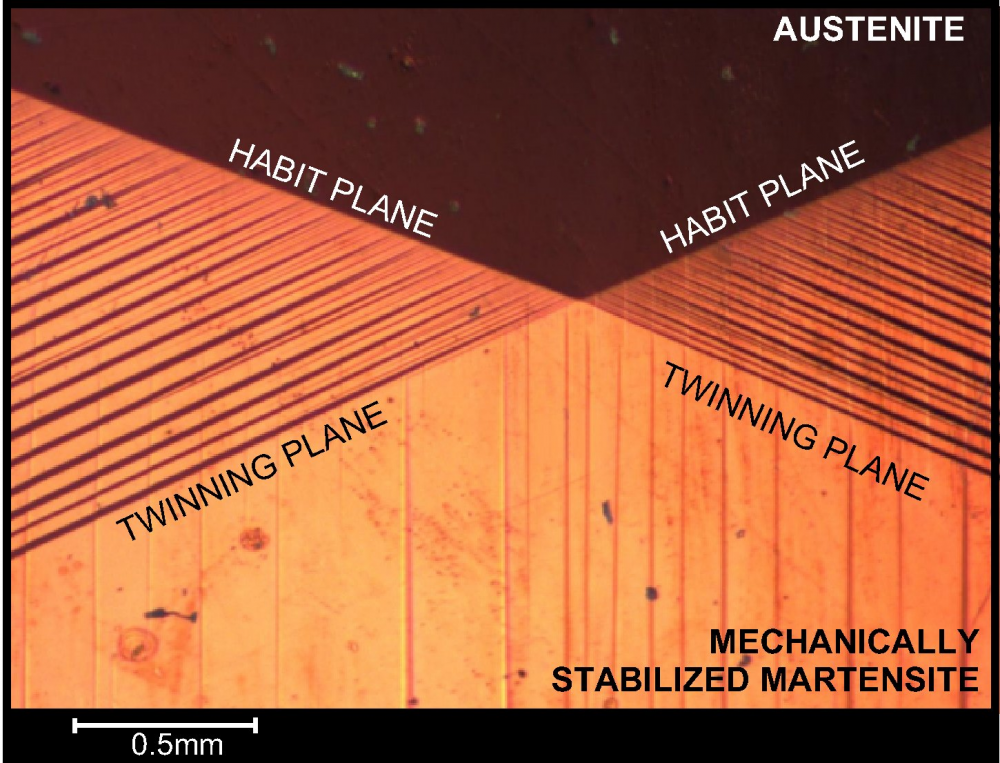 |
Martensitic microstructures forming between austenite and the mechanically stabilized martensite in the single crystals of SMAs is observed by optical microscopy (2D analysis) and white-light interferometry (3D analysis). The results are compared to the predictions of the mathematical theory of martensitic microstructures. The experiments are done on Cu-Al-Ni single crystals. |
Mathematical modeling of elastically stressed martensitic microstructures |
|
 |
Finite element methods are used to analyze the elastic strain fields in interfacial martensitic microstructures, whereto the mesoscopic geometry of the microstructure is taken directly form the optical observations. The results enable the stored elastic energy to be evaluated and, consequently, the thermodynamic stability of individual microstructures to be discussed. Responsible researcher: Ondřej GLATZ, Hanuš SEINER Related publications: [IJMCE-09], [ESO-09a], [IJSS-11] |
Constitutive modeling of the thermomechanical behavior or SMA wires |
|
 |
A novel phenonemological algorithm is developed for predicting the behavior of NiTi shape memory wire elements under mechanical and thermal loading. The incorporated constitutive relation takes into account the key shape memory effects, e.g. superelasticity, pseudoplasticity, one-way shape memory effect, return point memory. Results of the numerical implementation of the algorithm are verified by comparison with experimental data. Responsible researcher: Miroslav FROST, Petr SEDLÁK Collaboration with: VTT Helsinki, Helsinki University of Technology Related publications: [JMEP-09], [ESO-09b], [EPJ-08] |
Ultrasonic evaluation of elastic coefficients of curvilinear anisotropy |
|
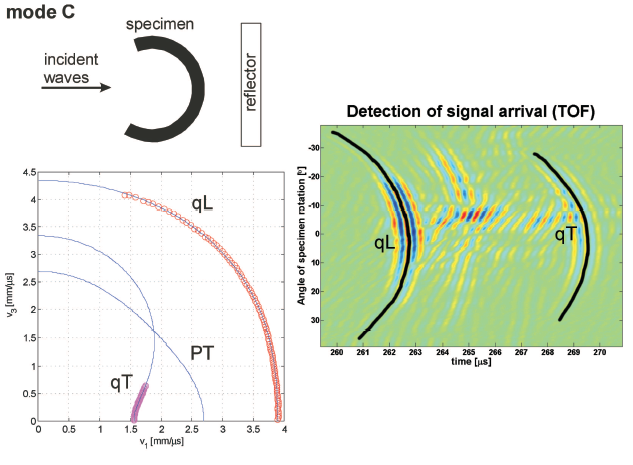 |
By using a simplified ray method, a mathematical model of interaction of planar acoustic waves with a curvilinear (cylindrical, spherical) anisotropic specimen is constructed. This model is then used for inverse determination of the elastic coefficients. The method was successfully applied on tubes made of fibrous composites and on cortical bovine bones Responsible research: Michal LANDA, Hanuš SEINER Collaboration with: Laboratory of Biomechanics at Faculty of Mechanical Engineering (CTU in Prague) Related publications: [BAM-05], [MCMBEC-07] |
Characterizing of phase transitions in SMAs via acoustic emission |
|
 |
Detecting the acoustic activity (emission of acoustic pulses) during transformation and reorientation processes in shape memory alloys, with the aim to identify the microstructural mechanisms and the temperature/loading ranges in which these mechanisms are activated. Responsible researcher: Michal LANDA Collaboration with: IoP ASCR Related publications: [JDP-03], [JAC-04], [ULT-04b] |
RUS analysis of anisotropic elasticity of rare-earth scandates |
|
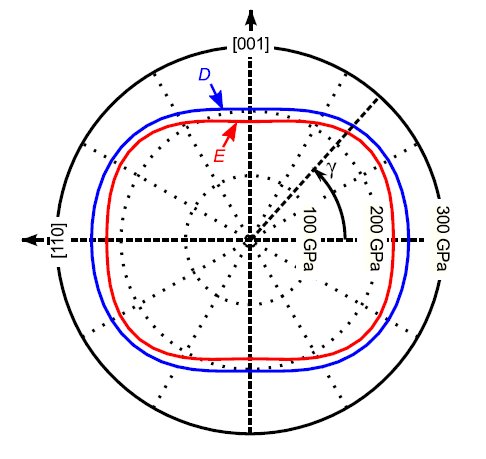 |
Determining the anisotropy of bending stiffness of DyScO3 single crystals used for epitaxial growth of thin functional films and studying the evolution of their elastic coefficients with temperature. The information obtained on thin substrates with various orientations is used for the construction of the full orthorhombic elastic tensor.
Responsible researcher: Michaela JANOVSKÁ |
Determination of in-plane elasticity of supported plasma-sprayed coatings |
|
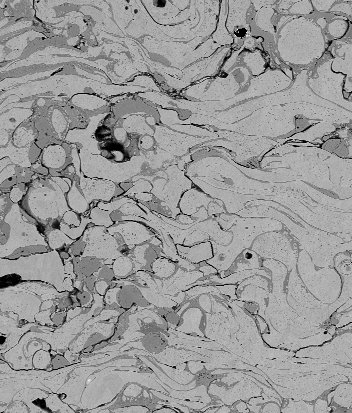 |
RUS analysis of as-sprayed coatings with high internal friction and possible heterogeneities; as these materials themselves cannot be set directly in resonance due to strong damping, their mechanical properties are determined from how the presence of such coating influences the vibrations of the underlying substrate. This method is used for HVOF and WSP coatings. Responsible researcher: Hanuš SEINER Collaboration with: IPP ASCR Related publications: in preparation |
Ultrasonic analysis of advanced ceramics prepared by SPS |
|
 |
Determination of elastic constants of ceramic materials and their possible spatial gradients by means of various ultrasonic methods. For a functionally graded silicon nitride, the profile of shear modulus along the phase composition gradient was determined from the asymetrization of modal shapes of free elastic vibrations of a small sample of this material.
Responsible researcher: Petr SEDLÁK, Hanuš SEINER, Martin KOLLER |
Acoustic DSC |
|
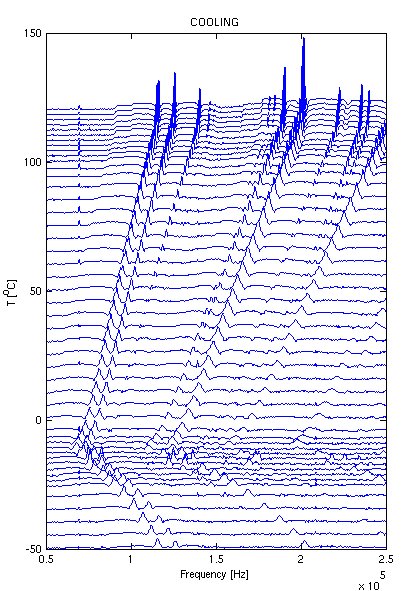 |
Detecting the transition temperatures and the temperatures corresponding to other thermally triggered/activated processes from the evolution of RUS resonant spectra with temperature (locations of the peaks and internal friction). Studied materials: thin functional layers (NiTi, NiMnGa, BaTiO3), single crystals (SMAs, rare-earth scandates), finely grained polycrystalline materials (e.g. AZ31 processed by ECAP), ceramics, etc.
Responsible researcher: Hanuš SEINER, Michaela JANOVSKÁ |